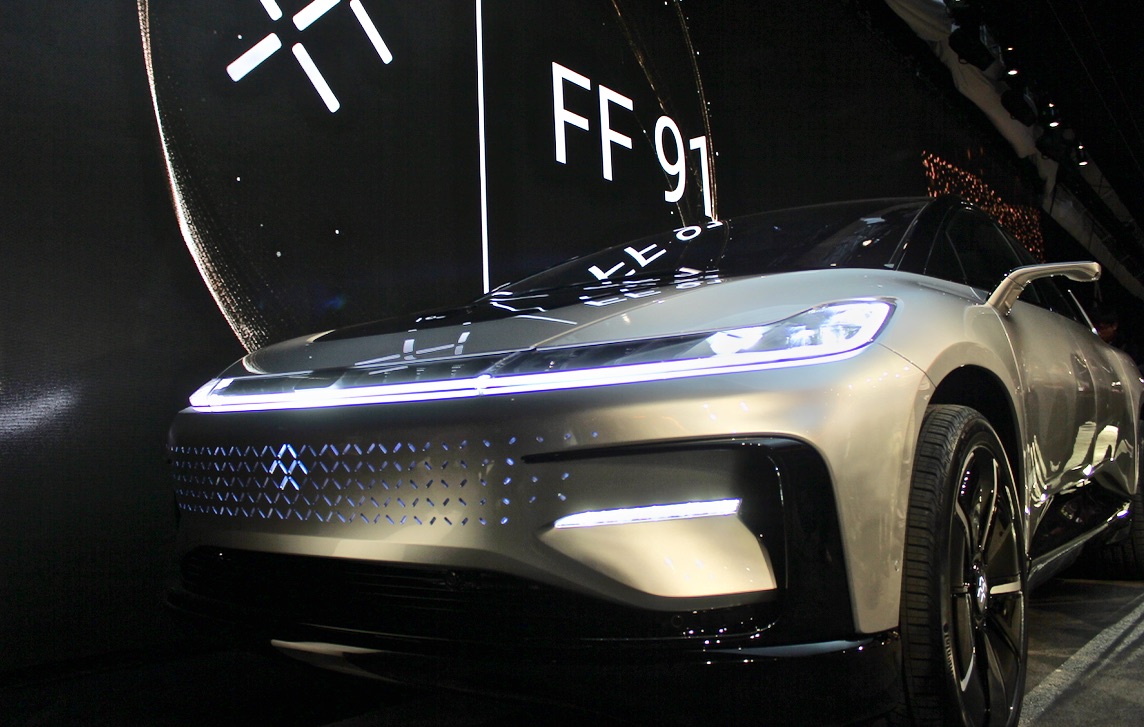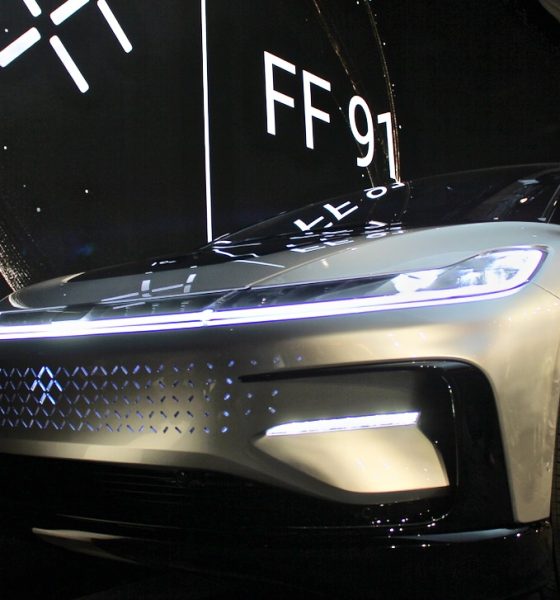

News
Will Faraday Future’s FF 91 ever see production without a factory?
Faraday Future finally took the wraps off its planned production car, named FF 91, last night at CES 2017. What the public finally saw was a low slung, four passenger crossover style vehicle that is intended to compete with the Tesla Model X.
The California-based electric car startup says the car will utilize an industry leading 130 kWh battery that’s capable of driving 378 miles on a single charge. Powered by three electric motors — one in front and two at the rear — FF 91’s all wheel drive system will be capable of blasting off a 0-60 mph time of 2.39 seconds, making it the world’s quickest electric vehicle.
The battery, which Faraday Future claims has the highest energy density in the industry, is supplied by LG Chem. Pete Savagian, vice president of propulsion engineering at Faraday, says the FF 91 is equipped for 200 kW fast charging and can charge at a rate of 500 miles per hour.
The rear doors are hinged at the rear to provide ease of access to the interior. The doors are fitted with radar sensors that protect them from damage from cars or objects parked nearby. Those sensors also are part of the advanced self-driving system built into the car. Rear seating is said to be spacious and sumptuous.
Those are the specs but specs don’t sell cars. People buy on emotion and justify their decision later with facts. The FF 91 is an emotional car in a way that the equally capable Lucid Air is not. The Lucid sedan looks like a very nice Audi. That’s not a bad thing; it just means it doesn’t have a lot of visual excitement. No car appeals to every taste, of course, but the FF 91 does have curb appeal. It is visually attractive and mimics the body lines of BMW’s i3 and i8 — thoroughly modern without being too bizarre.
Richard Kim, Faraday Future’s head of design, says much of the car was designed using virtual reality technology. “If you want to have the most progressive, forward thinking vehicle design, you have to have use the most progressive and forward thinking methodologies,” Kim told Automotive News during a tour of the company’s headquarters in Gardena, California late last year.
Faraday Future says owners will be assigned an FFID — a personal identification code that will allow any Faraday Future car to configure itself to the personal preferences of the owner. That raises a significant point. Will there ever be enough Faraday Future cars on the road to make FFID relevant? The company is said to have serious financial difficulties. Work on its factory in North Las Vegas has been shut down for almost two months and senior company executives have left the company in the past few weeks.
Not to worry, Nick Sampson, senior vice president of R&D and engineering, told the audience Tuesday night in Las Vegas. Brimming with confidence, he assured those in attendance that Faraday Future is in the middle of a “multifaceted disruption” that will “reformat the auto industry.” Then he added, “Despite all the naysayers and the skeptics, we will persist,” before adding that the company’s “clean sheet” gives it an advantage over traditional automakers. Maybe so. But with the first cars scheduled to be delivered in 2018 and no factory yet in existence, there are plenty of skeptics.
Are Faraday Future and the FF 91 ready for prime time? Interested parties can reserve a car now or pay a $5,000 fee to secure a “priority reservation” for one of 300 “Alliance Edition” cars. With the company teetering on the edge of financial collapse, the CES reveal is seen by many as a Hail Mary event. If the reaction to the FF 91 is positive, new investors may be brought on board. But without fresh funds, it is hard to see how the company can survive long enough to be part of CES 2018.

News
Tesla (TSLA) receives “Buy” rating and $551 PT from Canaccord Genuity
He also maintained a “Buy” rating for TSLA stock over the company’s improving long-term outlook, which is driven by autonomy and robotics.

Canaccord Genuity analyst George Gianarikas raised his Tesla (NASDAQ:TSLA) price target from $482 to $551. He also maintained a “Buy” rating for TSLA stock over the company’s improving long-term outlook, which is driven by autonomy and robotics.
The analyst’s updated note
Gianarikas lowered his 4Q25 delivery estimates but pointed to several positive factors in the Tesla story. He noted that EV adoption in emerging markets is gaining pace, and progress in FSD and the Robotaxi rollout in 2026 represent major upside drivers. Further progress in the Optimus program next year could also add more momentum for the electric vehicle maker.
“Overall, yes, 4Q25 delivery expectations are being revised lower. However, the reset in the US EV market is laying the groundwork for a more durable and attractive long-term demand environment.
“At the same time, EV penetration in emerging markets is accelerating, reinforcing Tesla’s potential multi‑year growth runway beyond the US. Global progress in FSD and the anticipated rollout of a larger robotaxi fleet in 2026 are increasingly important components of the Tesla equity story and could provide sentiment tailwinds,” the analyst wrote.
Tesla’s busy 2026
The upcoming year would be a busy one for Tesla, considering the company’s plans and targets. The autonomous two-seat Cybercab has been confirmed to start production sometime in Q2 2026, as per Elon Musk during the 2025 Annual Shareholder Meeting.
Apart from this, Tesla is also expected to unveil the next-generation Roadster on April 1, 2026. Tesla is also expected to start high-volume production of the Tesla Semi in Nevada next year.
Apart from vehicle launches, Tesla has expressed its intentions to significantly ramp the rollout of FSD to several regions worldwide, such as Europe. Plans are also underway to launch more Robotaxi networks in several more key areas across the United States.
News
Waymo sues Santa Monica over order to halt overnight charging sessions
In its complaint, Waymo argued that its self-driving cars’ operations do not constitute a public nuisance, and compliance with the city’s order would cause the company irreparable harm.

Waymo has filed a lawsuit against the City of Santa Monica in Los Angeles County Superior Court, seeking to block an order that requires the company to cease overnight charging at two facilities.
In its complaint, Waymo argued that its self-driving cars’ operations do not constitute a public nuisance, and compliance with the city’s order would cause the company irreparable harm.
Nuisance claims
As noted in a report from the Los Angeles Times, Waymo’s two charging sites at Euclid Street and Broadway have operated for about a year, supporting the company’s growing fleet with round-the-clock activity. Unfortunately, this has also resulted in residents in the area reportedly being unable to sleep due to incessant beeping from self-driving taxis that are moving in and out of the charging stations around the clock.
Frustrated residents have protested against the Waymos by blocking the vehicles’ paths, placing cones, and “stacking” cars to create backups. This has also resulted in multiple calls to the police.
Last month, the city issued an order to Waymo and its charging partner, Voltera, to cease overnight operations at the charging locations, stating that the self-driving vehicles’ activities at night were a public nuisance. A December 15 meeting yielded no agreement on mitigations like software rerouting. Waymo proposed changes, but the city reportedly insisted that nothing would satisfy the irate residents.
“We are disappointed that the City has chosen an adversarial path over a collaborative one. The City’s position has been to insist that no actions taken or proposed by Waymo would satisfy the complaining neighbors and therefore must be deemed insufficient,” a Waymo spokesperson stated.
Waymo pushes back
In its legal complaint, Waymo stated that its “activities at the Broadway Facilities do not constitute a public nuisance.” The company also noted that it “faces imminent and irreparable harm to its operations, employees, and customers” from the city’s order. The suit also stated that the city was fully aware that the Voltera charging sites would be operating around the clock to support Waymo’s self-driving taxis.
The company highlighted over one million trips in Santa Monica since launch, with more than 50,000 rides starting or ending there in November alone. Waymo also criticized the city for adopting a contentious strategy against businesses.
“The City of Santa Monica’s recent actions are inconsistent with its stated goal of attracting investment. At a time when the City faces a serious fiscal crisis, officials are choosing to obstruct properly permitted investment rather than fostering a ‘ready for business’ environment,” Waymo stated.
News
Tesla FSD v14.2.2 is getting rave reviews from drivers
So far, early testers have reported buttery-smooth drives with confident performance, even at night or on twisty roads.

Tesla Full Self-Driving (Supervised) v14.2.2 is receiving positive reviews from owners, with several drivers praising the build’s lack of hesitation during lane changes and its smoother decision-making, among others.
The update, which started rolling out on Monday, also adds features like dynamic arrival pin adjustment. So far, early testers have reported buttery-smooth drives with confident performance, even at night or on twisty roads.
Owners highlight major improvements
Longtime Tesla owner and FSD user @BLKMDL3 shared a detailed 10-hour impression of FSD v14.2.2, noting that the system exhibited “zero lane change hesitation” and “extremely refined” lane choices. He praised Mad Max mode’s performance, stellar parking in locations including ticket dispensers, and impressive canyon runs even in dark conditions.
Fellow FSD user Dan Burkland reported an hour of FSD v14.2.2’s nighttime driving with “zero hesitations” and “buttery smooth” confidence reminiscent of Robotaxi rides in areas such as Austin, Texas. Veteran FSD user Whole Mars Catalog also demonstrated voice navigation via Grok, while Tesla owner Devin Olsen completed a nearly two-hour drive with FSD v14.2.2 in heavy traffic and rain with strong performance.
Closer to unsupervised
FSD has been receiving rave reviews, even from Tesla’s competitors. Xpeng CEO He Xiaopeng, for one, offered fresh praise for FSD v14.2 after visiting Silicon Valley. Following extended test drives of Tesla vehicles running the latest FSD software, He stated that the system has made major strides, reinforcing his view that Tesla’s approach to autonomy is indeed the proper path towards autonomy.
According to He, Tesla’s FSD has evolved from a smooth Level 2 advanced driver assistance system into what he described as a “near-Level 4” experience in terms of capabilities. While acknowledging that areas of improvement are still present, the Xpeng CEO stated that FSD’s current iteration significantly surpasses last year’s capabilities. He also reiterated his belief that Tesla’s strategy of using the same autonomous software and hardware architecture across private vehicles and robotaxis is the right long-term approach, as it would allow users to bypass intermediate autonomy stages and move closer to Level 4 functionality.









